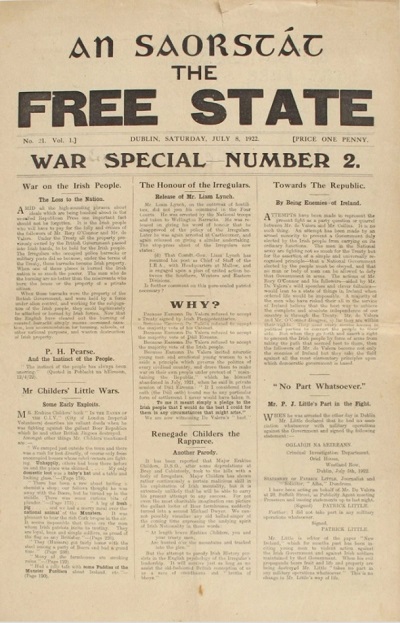Life
| [William Fanaghan Lynch;] b. 20 Nov., Baurnagurrahy, Anglesboro, Cork [nr. Mitchelstown]; son of Jeremiah and Mary [née Kelly] Lynch; ed. Anglesboro National School [12 yrs.]; employed as hardware store shop-assistant, Mitchelstown (aetat. 17); joined Gaelic League an AOH; worked in Fermoy in Barry’s Timber Yard; became a Republican in the sequel to 1916 Rising, on seeing the Kent brothers under arrest in Cork; |
| served as 1st Lieutenant in Fermoy company of Irish Volunteers; commanded Cork 2nd Brigade of the IRA during War of Independence; a principal in the capture of Gen. Cuthbert Lucas, who then escaped; arrested with others in Cork City Hall, Aug. 1920 - giving a false name and soon released; ambushed British Forces at Millstreet [town], killing 13; organised the flying columns; conducted successful arms raid on Mallow Barracks with Ernie O’Malley and others, Sept. 1920; |
| appt. commander of 1st Southern Division, 20th April 1921; sought to unite the IRA after the Treaty by issuing a Republican Constitution contrary to the terms of the Irish Free State; elected Chief of Staff of the old IRA in the Civil War (26 March 1922), parting with Collins in the IRB Supreme Council; resisted IRA plan to resume hostilities against British Forces at Third Army Convention, 18 June, 1922; succeeded by Joe McKelvey, 29 June 1922 but assumed leadership of anti-Treaty IRA, 10 April 1922; |
| arrested in Dublin by General Duffy but permitted to leave; released by Free State officers again in Kilkenny on understanding that he would not participate in Civil War; accused of breaching such promises but adamantly denied having given any; sought to establish Munster Republic; established Waterford-Limerick Line; Limerick fell to Free State forces, 20 July 1922; retired to Fermoy; issued ‘orders of frightfulness’, 30 Nov. 1922 sanctioning killing of Free State TDs; responded with assassionation of Sean Hales and others following the execution of captured Republicans incl. Erskine Childers (17 Nov. 1922); criticised by Republicans for failure to act swiftly against Free State; |
| met members of the anti-Treaty forces in Nire Valley and narrowly won vote to continue the war; mortally wounded in Free State operation in the Knockmealdowns, 10 April 1923; d. on the same day in Clonmel Hospital; bur. Kilcrumper Cemetary; Civil War ended by his successor Frank Aiken; commemorated by an Irish round tower at the spot where he was shot, opened by Eamon de Valera, then in power, 7 April 1935; his last tunic on display in Collins Barracks National Museum. [DIH Wikípedia] |
[ top ]
Criticism| Full-length studies |
|
| Correspondence |
|
[ top ]
Commentary
Lucille Redmond, review of Meda Ryan, The Real Chief: Liam Lynch (2005), in Books Ireland (Sept. 2005): while employed in a hardware store in Fermoy Lynch witnessed the arrest of four sons of a neighbour in gun-battle with RIC in the wake of the 1916 Rising, three of whom were subsequently killed in detention; built up Flying Columns to combat mobile British forces garrisoned in Ireland; primus inter pares with Sean Moylan, Tom Barry, Liam Deasy and Dan Breen; organised levy system to support IRA forces in southern Ireland; had his HQ in the Irish-speaking Mac Suibhne house in Coolea; defied Dublin leadership, represented by Ernie O’Malley; in post-treaty period he captured 42 Ulster loyalists as hostages to prevent the hanging of three IRA men in Derry, afterwards swapping guns supplied by treaty-government (and ultimately by the British) with those held by the Northern brigade in order to mount IRA attack with the collusion of Collins; determined to fight on for an all-Ireland republic after Breen and others counselled peace; wrote a note congratulating Liam Deasy on the death of Collins (‘successful operation’); shot in stomach by Free State forces in Knockmealdown Mts. while others incl. de Valera are said to have fled. (Books Ireland, 2005, 192-93.)
| The Honour of the Irregulars (Saorstát, July 8, 1922) | ||

|
||
| —Click here to see enlargement - as attached. |
[ top ]
Notes
Gerard Shannon, Liam Lynch: To Declare a Republic (Dublin: March 2023) - publisher’s notice: General Liam Lynch was a key figure in the Irish Revolution and remains one of the most celebrated IRA leaders of his era. His republicanism was shaped both by his upbringing in Limerick and by the aftermath of the Easter Rising. By the time of the War of Independence, Lynch was in command of the IRA’s Cork No. 2 Brigade and masterminded some of the most important actions against British forces, such as the Fermoy arms raid and the daring kidnapping of British General Cuthbert Lucas. / Adamantly opposed to the Anglo-Irish Treaty, regarding it a betrayal of the Irish Republic, Lynch became chief of staff to the IRA men who opposed the settlement. Yet he remained determined to find a compromise with former comrades, which left him little prepared for the outbreak of the Irish Civil War. / Lynch would not live to see the end of the bitter conflict – he was mortally wounded following a dramatic pursuit by Free State forces across a mountain in south Tipperary – yet his controversial leadership of the IRA during the eleven-month Civil War continues to shape his legacy today. / In this long-awaited and fascinating new biography, the first in nearly forty years, historian Gerard Shannon delves deep into a wide array of archival material to create a detailed, nuanced portrait of a hugely significant and influential figure in Irish history.